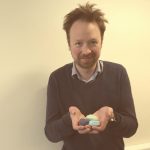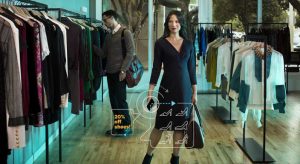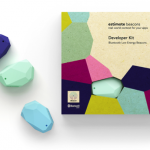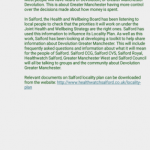
Have you heard about beacons? How do beacons work? Beacons are one of many technologies that Salford Business School’s PUPRU is working with. If you don’t know by now what #PUPRU is, you can read about it here. The #PUPRU team are a group from the Centre for Digital Business with a focus on researching the use of emerging and disruptive technologies in business. Disruptive technology is defined as:
… new digital goods and services that revolutionise, change and disrupt accepted methods of performing business activities and transactions …
We have all been exposed to disruptive technologies, but perhaps not been aware. All disruptive technologies have potential to be the next big thing, creating significant opportunity, as with past disrupters like the Internet, smart phones and Google. You may not see the relevance, but unforeseen digital disruption drastically impacts business revenues. For example, GAME group closed 277 stores in the UK and Ireland in 2012 when consumer habits changed and more people began downloading their games. EE’s 2015 third quarter results showed a 10.3% collapse in voice minute revenue as customers moved to VOIP communication apps like Facebook Messenger, WhatsApp, and WeChat. Desktop PCs and laptop sales declined by 9.5% in 2015 with increased global demand for tablets and smart phones. It is no longer necessary for you to own desktop PC devices when there are cheaper mobile alternatives, offering mobility and additional functionality. A new service could disrupt an existing business and is a strong motivator to rethink IT strategy and align it with business strategy. This is where #PUPRU comes in and looks to engage with organisations investigating the use of emerging disruptive technologies in their strategies.
Now – to beacons – what are they?
What are Beacon Technologies?

Beacons are small sensors which can be stuck anywhere to provide context and micro-location to smart devices. In retail, they have been successfully used to drive customer loyalty and in-store sales. Beacons are proximity-based, sending Bluetooth signals to a customer’s mobile device when they within 50-100 feet of the device, automatically triggering personalised coupons, offers, and loyalty rewards. They can even be linked to contactless payments, speeding up the checkout process. Retail giants have begun to experiment with beacons and the trend is catching on. Smaller retailers are following fast in getting on board because they are quite cheap, relative easy to use. They acknowledge that shoppers have started to use their mobile phones in stores, which in academic terminology is referred to as “showrooming”.

Beacon technologies are used in retail for lots of reasons:
- Customer convenience – shoppers do like to use their mobile applications to comparison shop in the store, and a retailer can benefit by triggering an offer at the moment they are likely to purchase.
- Enhanced shopping experience – Retailers are moving away from a transactional mindset to focus on enhancing the shopping experience, giving customers more than they expected. Beacons can do this by pushing personalised coupons, offers, and rewards.
- Affordability – These technologies are relatively cheap which makes them affordable to even smaller businesses.
- The need to compete with larger retailers – Typically a small business could not afford investment in disruptive technologies and they would be only accessible by larger retailers – the low cost of beacons levels this playing field.
- Understanding customers – Beacon-enabled applications collect data on customers’ spending habits and product preferences, enabling creation of personalised, immediate and targeted offers.
But the #PUPRU team believe beacon technologies could potentially do more.
We think there is potential to use beacons in other business contexts as well as the educational and public sectors. We can already see potential use cases can falling into two categories:
- For customers: could improve experience through push notification, broadcasting, self-guided tours, social networking functions, parking information & assistance, location and information at conferences and events.
- For business owners & sector managers: there is the potential to track items within the company via mobile device accelerometers, optimise flow of services and understand the customer preference more fully.
So, what experiments have the #PUPRU team been doing with beacons so far?
Well, we have been exploring some potential use cases in health care services that digitally contextualise:
- Navigation of buildings and spaces – the beacons can be used as a virtual map to show helpful information to customers.
- Geo-location – location tracking of patients and visitors.
- Analysis of people as they move throughout a hospital – they could measure footfall, allowing responsive management of blockages and gaining a fine granular understanding of how people use a building.
- Presentation of information in context to location – wouldn’t it be useful show information about the nearby clinics waiting times, wards and facilities through mobile device of visitors?
- Smart signage – in a multi-cultural society would it not be valuable to push translation of advertisements or visitor information based on their smart phone settings?
- Tracking of assets – digitally following the movement of large items as they move around a hospital.
- Leveraging distributed networks – beacon are able to communicate with each other and even act as wireless access points.
- Creation of an intelligent healthcare environment – how can beacons be used to improve medical team access to patient records and medical history?
We have started to test some of these ideas. Our fiest test was at the NHS Salford Citizens’ Panel Event held at the end of March in Salford Lighthouse. A beacon demonstration application was developed to provide information to users of two stalls and one information point at the event. Samsung tablets were taken to the event with our prototype application installed for participant experiment and observation allowing us to evaluate the use of beacon technologies as a public sector events. Three beacons were placed where stalls and information points were located. Participants wishing to know details about what is happening in each place could use a tablet and relevant information would be displayed on screen when they are near to a beacon:



#PUPRU is a fascinating project, and the team are always ready to listen to ideas. If you want to know what is going on please get in touch with our project coordinator, and we are even on Twitter so you can follow us, and find out what we are talking about.